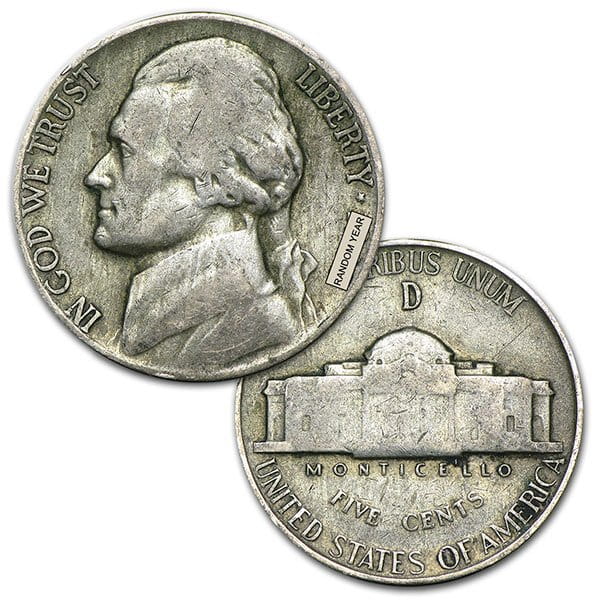In 1866, the Mint produced new five-cent coins made of nickel and copper, which people called “nickels”. The Mint continued making the smaller silver half dime until 1873. From 1913 to 1938, the Mint produced the iconic “Buffalo” nickel, designed by James Earle Fraser. Few nickels had circulated in the western states before the 1880s (people there preferred silver and gold coins); interest in the new Liberty Head design had led to increasing use of nickels there. Good economic conditions and high demand for nickels for use in coin-operated devices caused the piece to circulate throughout the nation by 1900.
Nickels minted in the United States between 1942 and 1945 are made of 35% silver. These are commonly known as 'silver war nickels.'
- Leading in numbers of Buffalo nickels struck is the Philadelphia mint. Throughout the years the main mint placed over 900 million nickels into circulation. Most of the old nickels found today are the Philadelphia issue. Many collectors find these coins appealing.
- Jefferson Nickels made between 1942 in 1945, are also called War Nickels and consisted of 35% silver. This means they are worth more than face value and most of them have been removed from circulation. An easy way to identify these more valuable coins is to look on the reverse. If there is a letter (P, D or S) over the dome of Monticello, then.
- 25 Most Valuable Nickels (Updated 2021) The CoinTrackers.com crew has compiled an awesome list we've dubbed 25 Most Valuable Nickels, and the page details the most valuable nickels minted in the United States from the late 1800's to the early 2000's. (Updated 2021) The values are descending so the most valuable are at the top.
Normally all other nickels are composed of 75% copper and 25% nickel. Due to the pressing need for industrial metals like nickel during World War II, five-cent coins were actually made from 35% pure silver during the duration of the war. The rest of the alloy was made up of copper (56%) and manganese (9%).
Interestingly, using this alloy meant that vending machines and coin-operated devices would still recognize and accept the silver nickels.
Nickels
P.S. -- Want to listen to this post?
How to Identify Silver War Nickels
At first glance, these silver nickels are difficult to distinguish from their copper-nickel counterparts. They look like any other old nickel to most of us. You'll see the same portrait of Thomas Jefferson on the obverse. Even the color is virtually identical.
Pile of war nickels


There are a few key visual differences you can keep an eye out for, however.
The easiest way to check for a silver war nickel is the year-date on the coin. All nickels produced from 1942 to 1945 use the 35% silver composition.
On the reverse (tails) side of the coin, you'll still find the familiar building known as Monticello, Jefferson's famous estate that he supposedly designed himself.
Nickels Coin
However, only the silver war nickels will place the mintmark on this side of the coin. The letter will either be a P, D, or an S prominently placed above Monticello
How to Tell If Your Coins Are Silver
Silver war nickels aren’t the only valuable coins you might find in your spare change. There are, in fact, several other silver coins you could potentially come across—and they’re actually 90% pure silver.

Chief among these are silver dimes. They generally come in three different varieties:
- Barber dimes (1892-1916)
- Mercury dimes (1916-1945)
- Roosevelt dimes (1946-1964)
Because of their relatively small size, quite a few of these dimes have survived in circulation. Less often you can still find 90% silver quarters, as well.
Coin dealers usually sell bank rolls or large bags of this “junk silver” grouped together by face value. Common increments are $100 or $1,000 face value.
This works because the amount of fine silver (by weight) in each coin denomination was roughly proportional to their face value.

In other words,
- a silver dime (10¢ face value) contains approximately 1/5th as much silver as a silver half dollar (50¢ face value);
- a silver quarter (25¢ face value) contains approximately 1/4th as much silver as a silver dollar (100¢ face value);
- and so on.
What Other Coins Are Silver?
Even in the United States, you may occasionally come across foreign silver coins in circulation. The most common are 80% silver coins from Canada.
Canadian 80% silver coins (quarters, half dollars, and dollars) were minted between 1920 and 1967. Prior to 1920, the 92.5% pure (.925 fine) sterling silver standard for British coins was used.
Some commemorative coins and proof sets issued by the U.S. Mint are still composed of 90% silver today in limited quantities.
The key thing to know:All U.S. dimes, quarters, and half dollars minted in 1964 or earlier are composed of 90% silver. Keep this fact in mind any time you decide to buy silver.
There are very specific dates for the Kennedy half dollar and Eisenhower dollar that are also made of 40% silver. Check the infographic below for more details!
Nickels Bbq
The Jefferson Nickel has been the longest running series for the five cent denomination. Featuring a portrait of Thomas Jefferson, the 3rd President of the United States, the design was introduced in 1938. This came after the introduction of the Lincoln Cent and Washington Quarter and represented the third series of American coinage to feature a former President on the obverse. During its long history, the Jefferson Nickel has undergone a temporary composition change and in recent years, a number of obverse and reverse design changes.
The original Jefferson Nickel was designed by Felix O. Schlag. A left-facing portrait of the former President is shown on the obverse with required inscriptions “In God We Trust”, “Liberty”, and the date. The reverse features an image of Jefferson’s historic home known as Monticello with inscriptions “E Pluribus Unum”, “United States of America”, “Monticello” and “Five Cents”.
Nickels And Dimes

This same design remained in use without any significant changes for more than six decades. Then, a series of design changes took place from 2004 to 2006 to commemorate the bicentennial of the Louisiana Purchase and Lewis and Clark’s expedition through the vast territory. Over the course of three years, theWestward Journey Nickels would feature four different reverse designs before reverting to the original image of Monticello. The obverse would feature two new portraits of Jefferson, with the second serving as the replacement going forward.
Despite its lengthy duration, the series remains an approachable one for beginning collectors. It is entirely possible to find the earlier dates of the series in circulation and even an uncirculated set does not include any expensive key date coins. Advanced collectors can also find challenge in assembling a set of gem condition coins with well defined strikes, as represented by the appearance of “Full Steps” on reverse.
This site provides basic information on the series of Jefferson Nickels, including the designs, mintages, coin specification, and important issues of the series. We hope that both beginning and advanced collectors will find the site informative and educational.